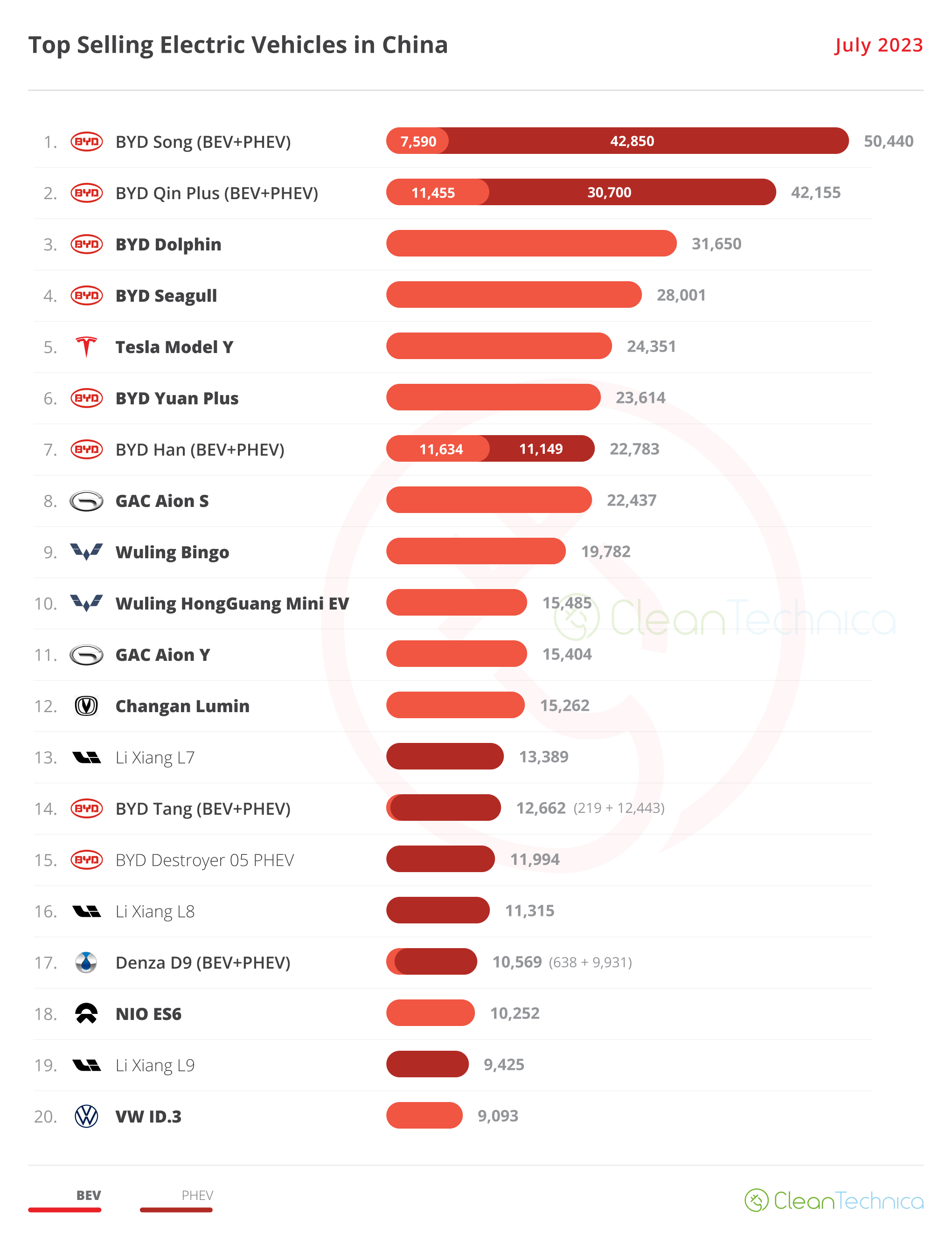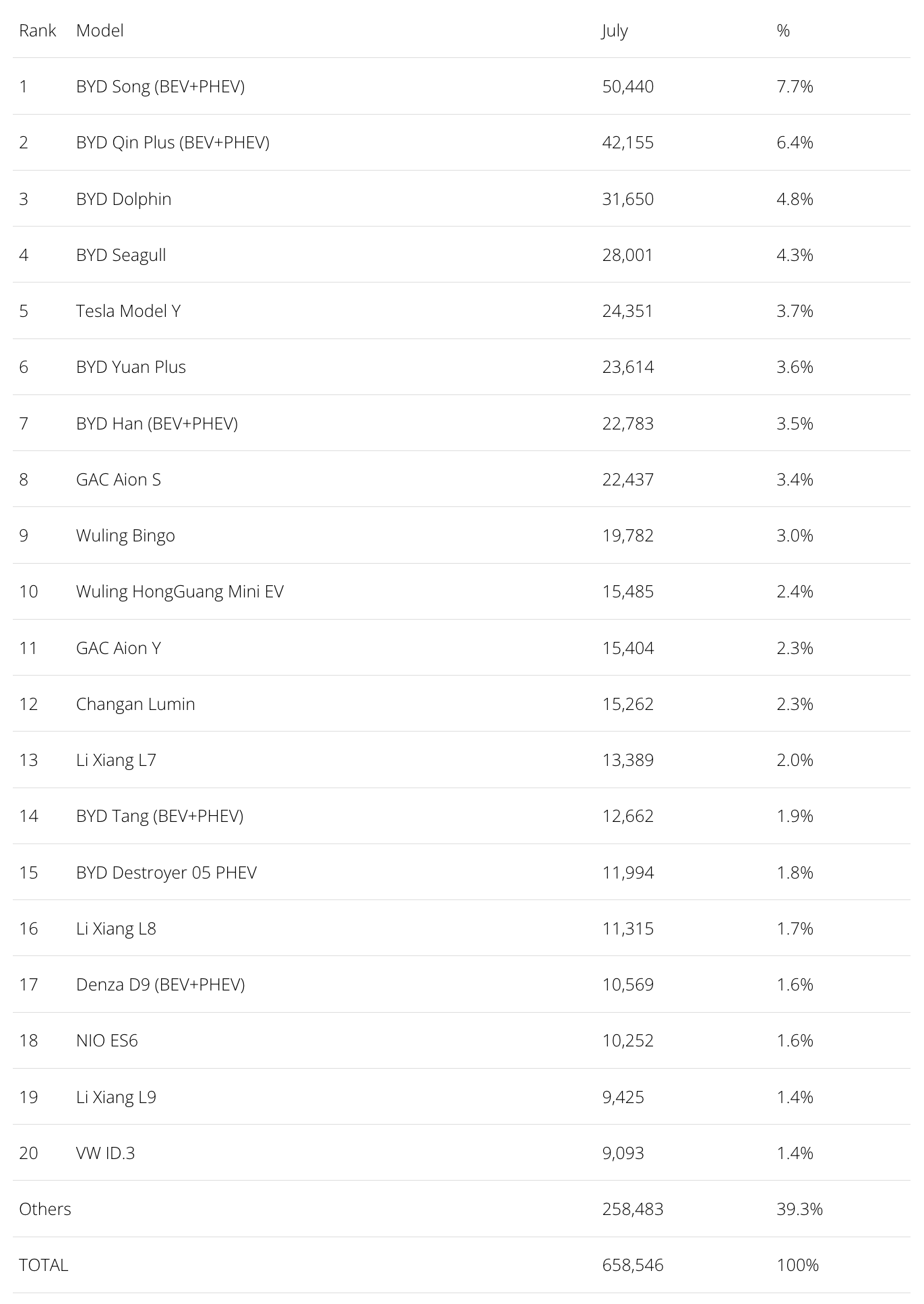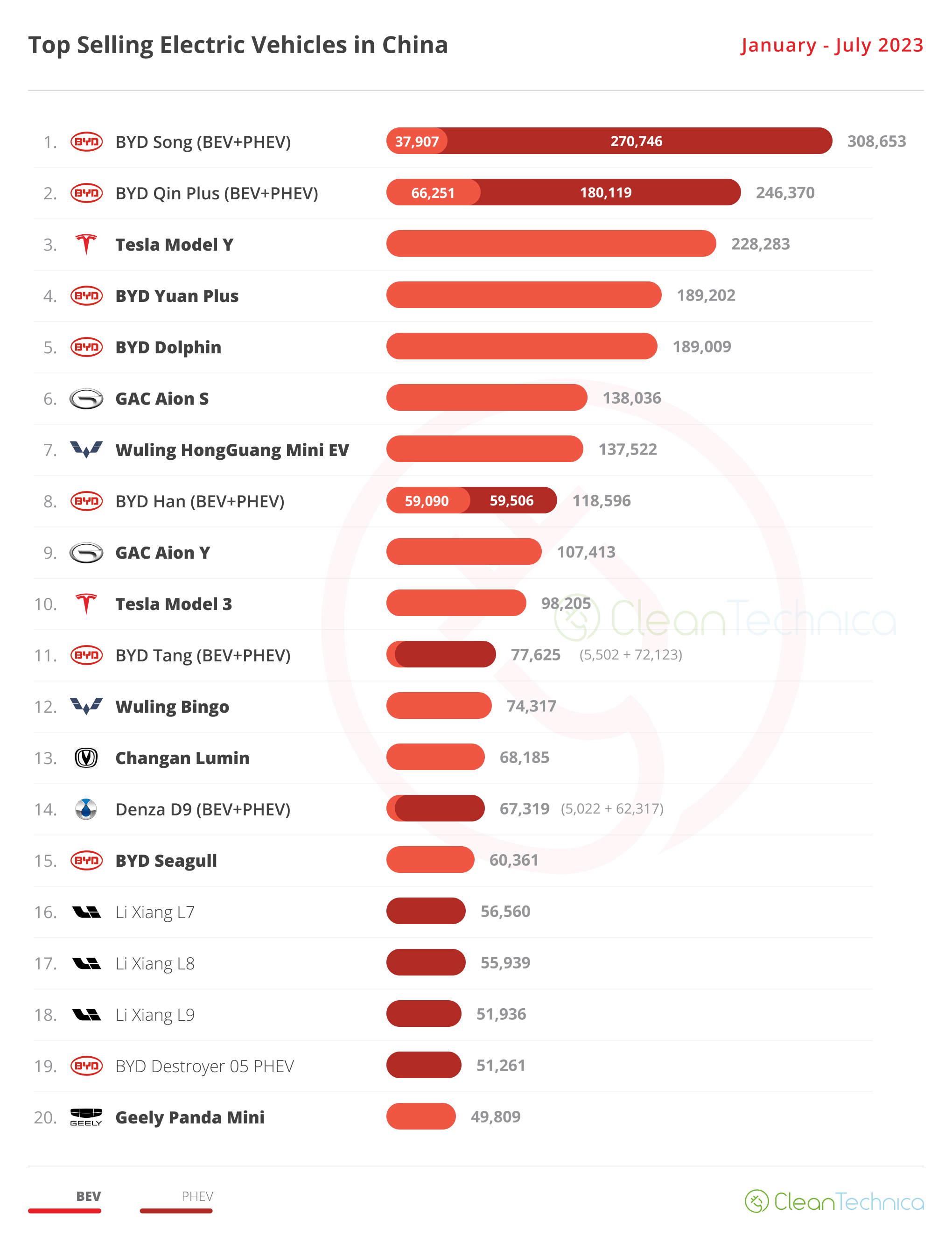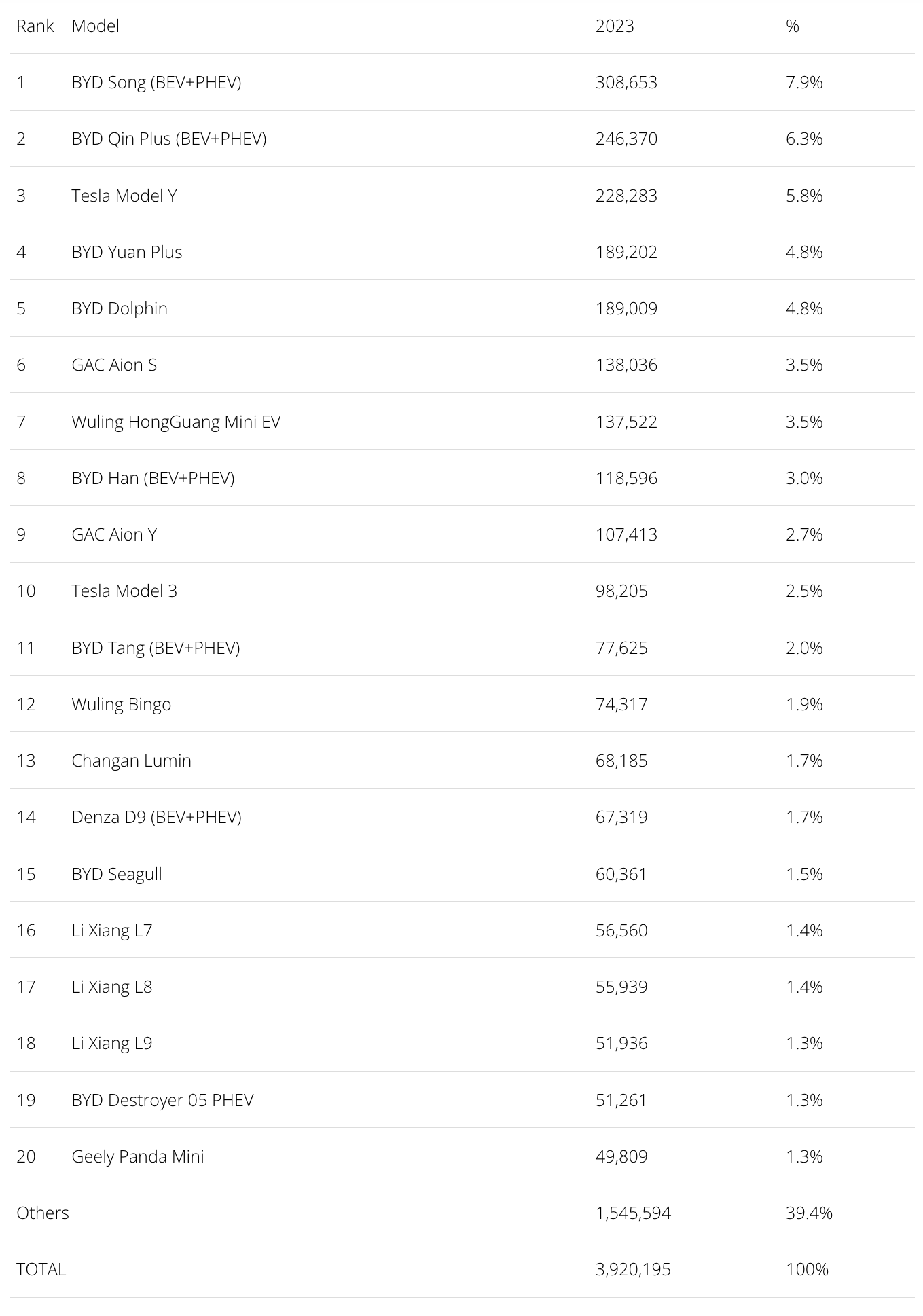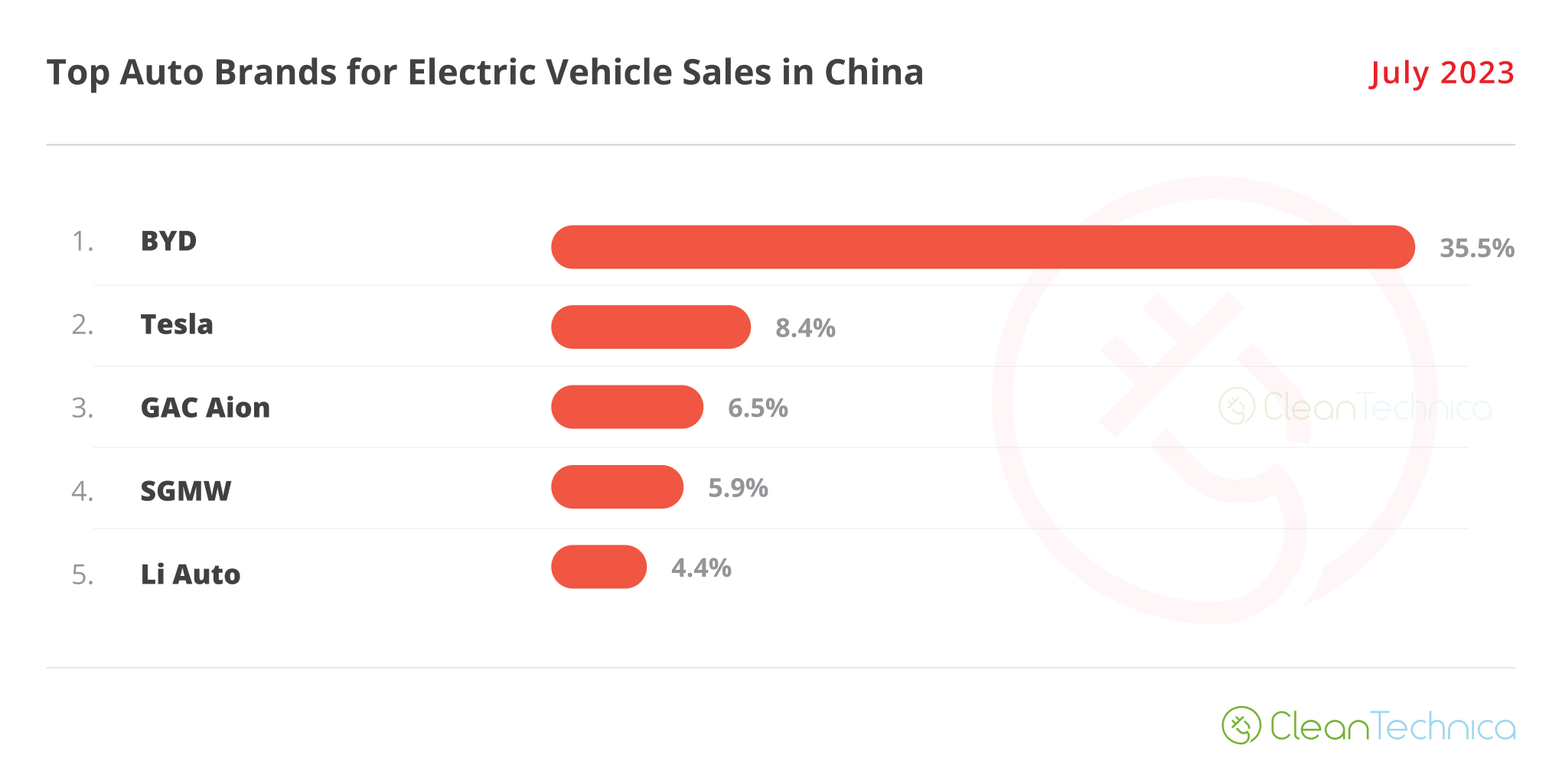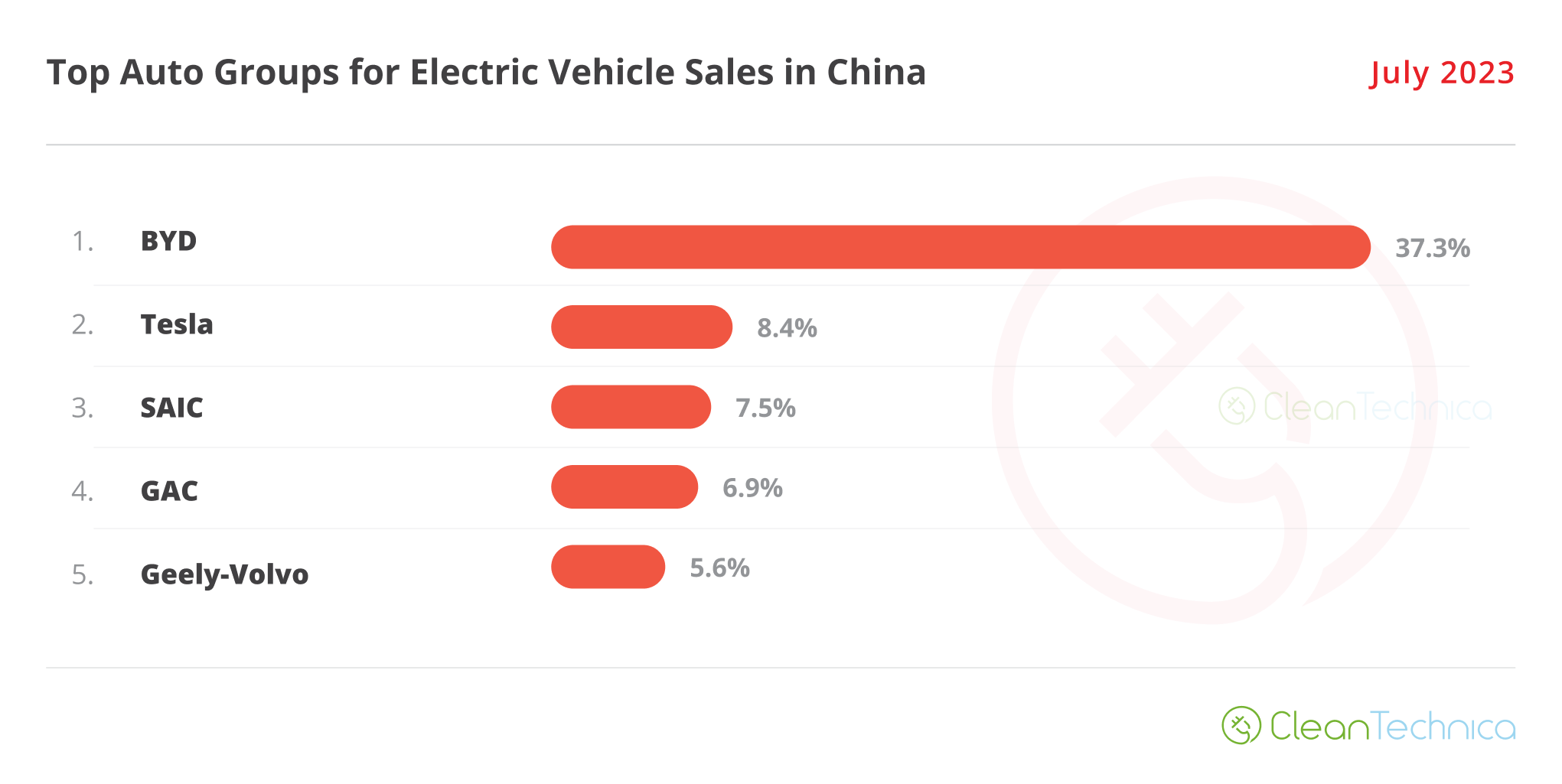
Plugin vehicles are all the rage in the Chinese auto market. Plugins scored over 658,000 sales last month, up 31% year over year (YoY). That pulled the year-to-date (YTD) tally to over 3.9 million units.
Share-wise, with July showing another great performance, plugin vehicles hit 38% market share! Full electrics (BEVs) alone accounted for 26% of the country’s auto sales. This pulled the 2023 share to 36% (24% BEVs), and considering the current growth rate, we can assume that China’s plugin vehicle market share will end over 40% by the end of 2023.
Another measure of the importance of this market is the fact that China alone represented around 60% of global plugin registrations last month!
Looking at July’s best sellers in the overall market, we see plugins populating the top positions, with 4 plugin models in the overall top 5. And to think: in other markets, we celebrate when one EV breaks into the overall top 10….
The 20 Best Selling Electric Vehicles in China — July 2023
Here’s more info and commentary on July’s top selling electric models, again with only BYDs and Teslas in the top 7 positions:
#1 — BYD Song (BEV+PHEV)
BYD’s midsize SUV was top dog in the overall Chinese automotive market, with BYD’s current star player scoring 50,440 registrations. Will the Song end the year as the best selling model in the Chinese automotive market? Well, it depends on the competition, especially the internal competition. Currently, the Song only has the recently introduced Frigate 07 PHEV as internal competition, but the upcoming Song L (BYD’s take on the Tesla Model Y theme) and its premium cousin, the Denza N7, are both set to land soon. This is probably too much competition inside BYD’s midsize SUV portfolio (the regular Song as the lower priced model, the Frigate 07 & Song L as mid-priced models, and finally the upmarket Denza N7). Also, the current wave of price cuts, which is spreading through the local market, will be a decisive factor. They will be decisive for the Song to continue clocking 40,000+ sales/month, a necessary threshold to continue leading the cutthroat Chinese auto market.
#2 — BYD Qin Plus (BEV+PHEV)
Thanks to a recent refresh and price cut, the BYD Qin Plus has been rejuvenated and its sales have jumped again. The midsizer reached 42,155 registrations in July, with the BEV version alone scoring 11,455 registrations. With prices now starting at 100,000 CNY ($15,000), demand is strong again, despite the fierce internal competition (the BYD Seal for the BEV version and the Destroyer 05 for the PHEV version). Expect BYD’s lower priced midsize sedan to continue posting strong results, at the cost of its most expensive siblings. It should have no problem keeping its most direct competitors, the Tesla Model 3 and GAC Aion S, at a safe distance.
#3 — BYD Dolphin
The small-to-compact Dolphin scored 31,650 registrations, a new record for the space-efficient EV. In the past, one could say that the Dolphin had its class all to itself, as its most direct competitors in this category were selling significantly fewer units. This success is now being tested by the recently introduced Wuling Bingo, which clocked a record 19,782-unit performance in July. Once the Bingo crosses the 20,000 units/month threshold, it could give the Dolphin a run for its money. The race in the small hatchback category could become even more entertaining to follow if the upcoming JAC Yiwei 3, said to receive sodium-ion batteries later this year, also becomes a success.
#4 — BYD Seagull
With 28,100 registrations, in only its third full month on the market, BYD’s future star player is ramping up fast, with the question now being: How high will it go? In its domestic market it should reach podium positions soon, but it is overseas that the little EV could be a true disruptive force: Latin America and Africa are waiting for a good, cheap EV that can push EVs into the mainstream, and the Seagull could be it. And this could be the model that places BYD among the best sellers in places like India or Europe, where good value-for-money BEVs are scarce. Sitting somewhere between the A and B segments, at 3.78 mt, and using a purposeful angular design, it profits from the brand’s leading Blade batteries, in 30 kWh and 39 kWh sizes. It starts at 74,000 CNY (+-$10,500 USD). The only model rivaling it is the slightly larger (3.95 mt) Wuling Bingo, which starts at 60,000 CNY (+-$8,200 USD), but at that price, it comes with a battery of just 17 kWh and no DC charging. For a similar-spec Bingo, equipped with a 32 kWh battery & DC charging, it starts at 74,000 CNY, the same price as the Seagull. So, spec-wise, both seem equally competitive, but the Seagull benefits from the current strength of the BYD brand, something that the Wuling EV lacks. Also, does SAIC (or GM) have export plans for this small EV?
#5 — Tesla Model Y
Tesla’s star model got 24,351 registrations, which was its best first-month-of-quarter market ever in China, so it seems the price cuts continue to spur demand for the US crossover, which might allow it to reach another record month in September. At a time when Chinese automakers are in peak form, Tesla is currently the only foreign OEM able to follow the amazing pace of the domestic carmakers, with the Model Y’s most immediate threat actually coming from its own stable in the form of the refreshed Tesla Model 3. If the price and specs are anywhere near what is being said, expect the sedan to start cannibalizing its crossover sibling during the coming months….
Looking at the rest of the table, the main highlight in the top half is the #9 Wuling Bingo scoring 19,782 sales, its second record performance in a row, not only beating its smaller sibling Wuling Mini EV, but also now looking to break the glass ceiling disrupt the BYD/Tesla duopoly at the top! The Wuling Bingo could reach the sales levels of the category leader, the BYD Dolphin.
Further below in the table, a highlight was in #12, with the Changan Lumin scoring a record 15,262 registrations thanks to a recent refresh. Elsewhere, Li Auto placed all three of its models in the top 20, with the L7 five-seater — the startup’s smallest model (the L9/L8/L7 are all full-size SUVs) — having another record month (13,389 registrations) while the slightly larger L8 seven-seater also hit a record result, 11,315 units. Even the Cadillac Escalade–like L9 got an amazing 9,425 registrations….
(Last month there were three models larger than 5 meters in the top 20 — the Li Xiang L9 & L8 as well as the Denza D9. Talk about automotive obesity….)
The hot startup brand has a winner trio on its hands. The cheapest model in the startup’s lineup (starting at $49,000) should continue to improve its standing in the near future, with Li Auto setting a bullish sales target of 400,000 units this year! And 800,000 in 2024!! And 1.6 million in 2025!!! :0
For these targets to be met, the midsize L6, due to be launched sometime next year, will be a critical part of the puzzle.
Still on the top 20, three other models deserve a mention. The #15 BYD Destroyer 05, a reskinned BYD Qin Plus PHEV, hit a record 11,994 registrations, its second record performance in a row. In #18, we have NIO’s new generation ES6, which recently landed on the market with a bang. It scored 10,252 registrations in July, the first five-digit performance in a month by any NIO model. Expect the ES6 to resume its role as the bread and butter model, allowing the startup to scale up its (much needed) production.

Finally, after a significant price drop, VW ID.3 sales surged in China, allowing the hatchback to reach the top 20 for the first time with a record 9,093 registrations. Who would have imagined — cutting prices DOES increase sales….
Outside the top 20, the highlights are varied. In Changan’s stable, the Deepal S7 SUV had 7,704 registrations, in only its second month on the market. A future best seller?
The Baojun Yep, a recently introduced pint-sized SUV (think micro Mercedes G-Class) delivered 5,305 units of its cutesy baby SUV, in only its third month on the market. Will the SGMW joint venture place in the top 20 soon?
Meanwhile, Leap Motor’s C11 midsize SUV scored another great performance, 8,298 registrations, no doubt helped by the introduction of a range-extended version that is now sold along with the regular BEV version.
The 20 Best Selling Electric Vehicles in China — January–July 2023
Looking at the 2023 ranking, the BYD Song is well above the competition, while the runner-up BYD Qin Plus has gained precious advantage over the #3 Tesla Model Y. Will the Chinese sedan continue resisting the US crossover’s pressure?
Off the podium, the table has remained relatively stable, with the first position change happening in #6 with the GAIC Aion S surpassing the Wuling Mini EV, thus becoming the first of the non-BYD/Tesla models.
In the second half of the table, we have the Wuling Bingo climbing one position to #12, while just below it, another small EV is also on the rise — the Changan Lumin was up to #13.
Below these two, we have two new BYD models in the table, with the small Seagull jumping to #15 in July while the Destroyer 05 is now #19.
Finally, we must mention the Li Auto models, with the L7 climbing to #17 and the L9 going up to #19. That makes three Li Auto models in the top 20. Apart from the all-mighty BYD, no one else has that many models in the top 20, and it speaks volumes about the startup’s current strength.
Top Selling Auto Brands & Auto Groups in Chinese EV Market
Looking at the auto brand ranking, there’s no major news. BYD (35.5%, up 0.2%) remains stable in its leadership position and is looking to win its 10th plugin automaker title this year, while off-peak Tesla (8.4%, down from 9.1%) is stable in second place.
Third-placed GAC Aion remained stable, at 6.5%, while the SGMW joint venture’s performance recovered slightly, helped by the “Bingo-effect” pulling its share from 5.8% in June to its current 5.9%.
Finally, 5th placed Li Auto continues on the rise (4.4%, up from 4.3%). This three-year-old startup is already reaching significant sales levels and looks set to become a force to be reckoned with in the future.
Despite staying off the radar of many analysts, Li Auto’s growth potential, price points, and margins are the most promising among current EV startups. Just to put the company’s amazing growth curve into context, in 2015, three years after the Model S launch, Tesla was celebrating a record 50,000 unit sales a year. At the same age, Li Auto does more than that in two months….
This is kind of a perfect s*** storm for legacy OEMs in China, with BYD and GAC going after their mainstream market volumes, Tesla hitting their midsize/premium offers hard, and Li Auto eating its way into the last bastion of profitability for foreign OEMs in China: full size models.
Looking at OEMs/automotive groups/alliances, BYD is comfortably leading with 37.3% share of the market, up 0.3% in July, while #2 Tesla (8.4%) also remains stable. With the SAIC mothership still in the red, the new Wuling Bingo helped to stop the current sales bleed — the Shanghai-based OEM was up from the 7.4% share it held in May to its current 7.5%, which was enough to allow it to retain the last position on the podium.
With #4 GAC (6.9%) getting closer, SAIC could have its bronze medal in danger soon.
One step down, #5 Geely–Volvo is slowly growing, now at 5.6% share, up 0.1% share compared to the previous month.
With #6 Changan stable at 4.5%, Geely can rest on its laurels for now while it looks for a way to surpass SAIC and/or GAC by the end of the year. (And maybe go after Tesla in 2024?)
I don’t like paywalls. You don’t like paywalls. Who likes paywalls? Here at CleanTechnica, we implemented a limited paywall for a while, but it always felt wrong — and it was always tough to decide what we should put behind there. In theory, your most exclusive and best content goes behind a paywall. But then fewer people read it! We just don’t like paywalls, and so we’ve decided to ditch ours. Unfortunately, the media business is still a tough, cut-throat business with tiny margins. It’s a never-ending Olympic challenge to stay above water or even perhaps — gasp — grow. So …

